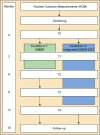Eye Movement Desensitization and Reprocessing with and without Dialectical Behavior Therapy for Posttraumatic Stress Disorder and Comorbid Borderline Personality Disorder Symptoms: A Randomized Controlled Trial
- PMID: 40015252
- PMCID: PMC12133105
- DOI: 10.1159/000544918
Eye Movement Desensitization and Reprocessing with and without Dialectical Behavior Therapy for Posttraumatic Stress Disorder and Comorbid Borderline Personality Disorder Symptoms: A Randomized Controlled Trial
Abstract
Introduction: Comorbidity between posttraumatic stress disorder (PTSD) and borderline personality disorder (BPD) is prevalent. Despite evidence-based therapies, high rates of nonresponse and dropout persist. This study therefore aimed to examine whether the concurrent application of eye movement desensitization and reprocessing (EMDR) for PTSD and dialectical behavior therapy (DBT) for BPD yields better results than EMDR alone.
Methods: Patients with a PTSD diagnosis and at least four BPD symptoms were randomly assigned to EMDR (n = 63) or concurrent EMDR-DBT (n = 61). Over 1 year, changes in PTSD symptoms were measured using the Clinician-Administered PTSD Scale for DSM-5. Secondary outcomes included BPD symptoms, global functioning, and quality of life.
Results: Both treatments led to large reductions in PTSD symptoms, without significant differences after 1 year (p = 0.312, d = -0.23, 95% CI = -0.6, 0.1). Both treatments also yielded large and comparable reductions in BPD symptoms and improved quality of life. Global functioning improved only in the EMDR condition according to one measure (World Health Organization Disability Assessment Schedule 2.0), while the other measure (Outcome Questionnaire 45) showed improvements in both groups. Additionally, patients in the EMDR-DBT condition were twice as likely to drop out from EMDR treatment compared to those in the EMDR-only condition.
Conclusion: Stand-alone EMDR demonstrated safety and efficacy in alleviating PTSD and BPD symptoms, as well as enhancing quality of life. These findings support the use of EMDR as a strong therapeutic option for patients with PTSD and comorbid BPD symptoms. Further research is needed to assess longer-term outcomes beyond 1 year.
Keywords: Borderline personality disorder; Posttraumatic stress disorder; Treatment.
© 2025 The Author(s). Published by S. Karger AG, Basel.
Conflict of interest statement
The authors have no conflicts of interest to declare.
Figures
References
-
- Frías Á, Palma C. Comorbidity between post-traumatic stress disorder and borderline personality disorder: a review. Psychopathology. 2015;48(1):1–10. - PubMed
-
- Barnicot K, Crawford M. Posttraumatic stress disorder in patients with borderline personality disorder: treatment outcomes and mediators. J Trauma Stress. 2018;31(6):899–908. - PubMed
-
- Hastrup LH, Jennum P, Ibsen R, Kjellberg J, Simonsen E. Societal costs of Borderline Personality Disorders: a matched‐controlled nationwide study of patients and spouses. Acta Psychiatr Scand. 2019;140(5):458–67. - PubMed
Publication types
MeSH terms
LinkOut - more resources
Full Text Sources
Medical



